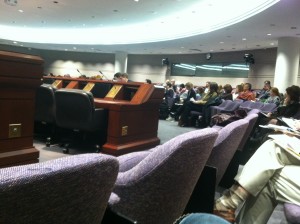HARTFORD, CT – On Monday, March 4 members of the Connecticut legislative body and local citizens alike met at the Legislative Office Building for a public hearing hosted by the Education Committee to discuss Senate Bill 1002 (SB 1002), a piece of legislation that the Committee introduced on February 27, 2013 that will establish community schools throughout Connecticut. The Coalition for Community Schools defines community schools as “both a place and a set of partnerships between the school and other community resources.” The community school model emphasizes a ‘bottom-up’ approach, relying on the participation and contribution of stakeholders – parents, educators, and local citizens – to create the best possible school for a given geographical area. These schools will aim to better the educational experience of students through a variety of comprehensive services that extend beyond classroom instruction. The strategy behind these schools involves a focus on not only academics but also students’ safe passage to and from school, students’ health and their home environments.

National Association for the Advancement of Colored People (NAACP) Chairperson Dr. Benjamin Foster took the floor as an expert in public education to provide his opinion on the benefits of community schools. He argued that these schools reaffirm minority students’ long-term goals and provide a well-rounded education that is not directed solely at the passage of state tests. “Tests alone, I repeat, tests alone will not gauge the psyche of our students and their aims and aspirations” he explains in support of SB 1002. At this time there are many different facets of education that are currently widening the achievement gap between students. Foster cites the “digital divide, healthcare, prenatal care, parental employment” as examples of issues that, on their faces, seem unrelated to education but are crucial.
There is a strong need for what Dr. Foster calls “cultural competency, the comprehension of others’ values” in order to establish a more harmonious learning environment and more effective discussions and lessons in the classroom. Dr. Foster explains that these community schools ought to adopt African American history “as a regular part of the curriculum” to be taught throughout the entire school year, not just with special emphasis during the month of February. He also called for the adoption of Latin American history into the regular curriculum. These measures, according to Foster, will increase cultural competency and enhance the learning experience for minority students at the new community schools.
Toward the end of his presentation, Dr. Foster provided recommendations for the Education Committee and the teachers’ union. He calls for more options for parents and students by way of improved schools, parent universities, and “mandatory economic literacy ensuring that our students understand how our economic system works.” Dr. Foster believes that the creation of community schools in Connecticut school districts will provide these advantages to local citizens.
The major benefit stemming from the creation of community schools, Dr. Foster explains, is that they will “provide our parents and students with more options.” Dr. Foster illuminates the fact that “there may be a musician, there may be a scientist, there may be a carpenter, or whatever, with that same student that scores low on the tests.” He states very firmly, “all of our kids have intelligence.” Unfortunately, at present, not all of our kids have equal opportunities and for that reason Dr. Foster is in favor of SB 1002.
Werner Oyanadal joined the discussion, representing the Latino & Puerto Rican Affairs Committee (LPRAC) as their Acting Executive Director. He also came to the hearing to voice his support for the community school model and SB 1002. Oyanadal calls not only for full-service community schools to be opened, but also for early learning programs that will prepare students from an early age. He referenced the massive achievement gaps among students of different racial groups; the achievement gaps in Connecticut are some of the highest in the nation. He expressed his hope that community schools would begin to close those substantial gaps.
According to Oyanadal, minority students experience major problems outside the classroom that prevent effective education, one of the most powerful being hunger. Community schools would provide all students with a wide range of services including longer school days and the offering of meals to students, which wouldl have a very positive effect on the students and their neighborhoods. He calls for schools to ask how they can get involved with the local community on a deeper level. Oyanadal states that after an evaluation of the surrounding neighborhood that a community school “becomes a beacon in the community” because it will provide the specific services that a given local population needs.
Senate Bill 1002 has been introduced with the hopes that the community school model will be established in the State of Connecticut. Proponents of the bill suggest that this new model of education will provide students with innumerable benefits and invaluable support that will take them straight through to college graduation and a successful future.